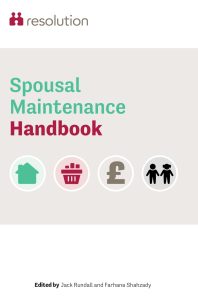Mind the Fair Shares Gap
With reform of financial remedies potentially on the cards, what should be the starting points for meaningful change?
 As practitioners know, spousal maintenance is a key target for future reform and has been under scrutiny for some time by leading reformers. At the time of writing, the Law Commission review is well underway with the objective to “address whether our laws are still working in the fairest way to support separating couples and avoid unnecessary conflict when it comes to dividing their finances”.
As practitioners know, spousal maintenance is a key target for future reform and has been under scrutiny for some time by leading reformers. At the time of writing, the Law Commission review is well underway with the objective to “address whether our laws are still working in the fairest way to support separating couples and avoid unnecessary conflict when it comes to dividing their finances”.
It is hoped a new set of clear principles or a formula can be constructed which will banish wide discretion and provide everyone with a predictable framework to deliver swift and consistent outcomes. The current system for financial provision, as set out in the Matrimonial Causes Act (MCA) 1973, is now over 50 years old which is why reformers call it “hopelessly out of date”. Baroness Deech instead applauds the Scottish system where maintenance is paid for a limited period, if at all (five years maximum unless the recipient can establish the high bar of “serious financial hardship as a result”). Furthermore, Baroness Deech calls for matrimonial assets to be divided equally and without recourse to non-matrimonial assets.
Without recourse to legal advice and/or judicial intervention at times, it may be hard for clients to differentiate between matrimonial and non-matrimonial assets or navigate tricky arguments about mingling or maintenance. The Fair Shares Report (FSR) spearheaded by Professor Emma Hitchings (“Fair Shares? Sorting out money and property on divorce”) identifies that only around two in five people (40%) obtain any information, advice or support when navigating divorce.
The FSR also importantly offers insight into the plight of women due to divorce, and the financial consequences, which includes the fact that they are more likely to “have part-time employment during the marriage and to earn less than husband, with 28% having take-home pay of under £1,000 per month compared to only 10% of men. Relatedly, women had accumulated poorer pension provision….” Only 11% of divorcees (with an undrawn pension) had a pension sharing order and it was usually the women who lost out.
Women, and in particular mothers with dependants were, on average, worse off financially than men even up to five years after the divorce, which is when the FSR survey took place. Additionally, for the “50s group of divorcees without children, women’s incomes were significantly lower than men. Women in this group were also more likely to be claiming both means-tested and disability benefits.”
The inferior financial position of women is not a new finding and the FSR acknowledges the work of Hayley Fisher and Hamish Low (“Divorce early or divorce late? The long-term financial consequences” (2018) 32 AJFL 6). There is an extensive international body of work establishing that divorce has a negative impact on women’s economic status compared to men, which is partly explained by differences between men and women in terms of earnings and labour market participation, especially since women on average earn less than men.
But the current discretionary system, with wide-ranging and versatile section 25 factors, clearly still has great value, however old. To lose discretion in favour of a one-size-fits-all formula could lead to some very unfair outcomes, not least because the last 50 years have not achieved gender or financial equality. Unlike the media portrayal of women as “gold-diggers”, women usually remain financially compromised, especially when one considers matters such as the pay, wealth and pension gap. Women still form the majority of those living in poverty and a premature clean break because of misplaced optimism that they can achieve financial independence or self-sufficiency is usually more fanciful than fair, especially when it comes to women with dependent children and/or if they are older and grappling with menopause and income-related issues.
Reform of financial remedies remains on the table with the new Labour government, but we should at least reflect, if not celebrate, that fairness and the yardstick of equality only arose in the seminal case of White v White (which, importantly, outlawed discrimination between the breadwinner and the home-maker) because the judiciary had the discretion to innovate and keep pace with societal standards. Fairness does not actually appear in the 1973 statute, but had to be intellectually engineered along with concepts such as compensation and sharing (Miller v Miller; McFarlane v McFarlane [2006] 2 FCR 213 (HL) in order to supplement and illuminate the statutory grey areas. Helping those less fortunate from falling between the gaps must never become old-fashioned.
info@moneypause.net
 Farhana Shahzady sits on National Committee and is co-chair of Resolution’s publications committee.
Farhana Shahzady sits on National Committee and is co-chair of Resolution’s publications committee.
She is co-editor of Resolution’s new Spousal Maintenance Handbook